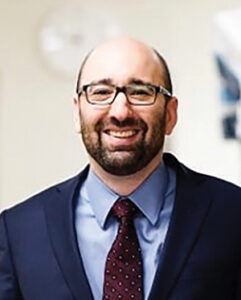By Stuart Foxman
When the Queensway Carleton Hospital in Ottawa decided to transform a hotel floor into a temporary patient ward in late April, the pharmacy team had to act quickly.
The hospital wanted to free up beds for COVID-19 patients, so they relocated some non-COVID patients to a floor at the Fairfield Inn & Suites, about 10 minutes away. That was in alignment with the government’s emergency order, under the Public Hospitals Act, to use additional premises for the purposes of a hospital. The hotel was closed to guests because of the pandemic. Among the logistics to consider: providing medications to patients.

Joe Dagenais, R.Ph., Pharmacy Director at Queensway Carleton, had an automated dispensing cabinet (ADC) installed in the hotel. ADCs aren’t new, but he had never used one offsite. Medication orders written at the hotel were faxed to the hospital for timely review by the pharmacy.
Orders were entered in the electronic health record system. Queensway Carleton’s IT team linked up the ADC so that pharmacy-reviewed orders could be profiled on the cabinet. When nurses withdrew meds, they were taking them out against these orders, says Dagenais.
Pharmacy shipped meds to the hotel via courier, using numbered and sealed tags to avoid tampering. For narcotics, the pharmacy technicians went to the hotel to load the ADC. Everything was done with a patient safety lens, says Dagenais.
He wasn’t the only one having to pivot quickly and safely.

So was Kristen Watt, R.Ph., across the province in Saugeen Shores, a small town nestled against Lake Huron in southwestern Ontario. Within a week, she went from active screening of patients, to transacting through a giant plastic sheet at the door of Kristen’s Pharmacy.
Watt found herself doing high volumes of phone consultations – so many that she installed another line. “At that point in the early days of the pandemic, the only things open were the gas station, grocery store and pharmacies,” she says.
The pandemic required many changes to community and hospital pharmacy practices to continue serving and protecting patients.
Everything happened fast. Patients began asking Watt about COVID-19 in January. She wasn’t especially concerned then. Why would she be? Canada didn’t even have a case yet. “The flu was more important,” says Watt.
She urged her patients to get the flu shot and practice good hand hygiene. The scale of what was to come with COVID-19 was hard to fathom. “It didn’t hit me yet,” Watt says.
Nor did it for Dagenais. When he heard reports about COVID-19 spreading in China, then into Europe, he worried about containment. Still, it wasn’t until Canada closed its borders that he felt how huge this might become. Even then, “we had no way of knowing,” he says.
COVID-19 has tested pharmacists’ abilities to respond to changing circumstances. Like others, Queensway Carleton and Kristen’s Pharmacy had to ramp up new ways to work amidst the uncertainty.
Watt was already providing free medication delivery, and asked the local emergency department to fax all prescriptions. She collaborated with other healthcare providers to ensure continuity of care. For instance, after a patient called with a suspected UTI, Watt contacted the patient’s doctor. The doctor, comfortable with Watt’s assessment and knowing the patient’s history of UTIs, gave a verbal order for an antibiotic.
Kristen’s Pharmacy became a healthcare hub. Many patients were worried about stepping foot in a hospital, so they called Watt for advice. “I was triaging,” she says.
One patient was afraid to travel to Toronto to get an Eligard ® injection for his prostate cancer. He asked if Watt could do it. While she has the scope to handle subcutaneous injections, Watt had never administered this particular drug. She did research, looked over the product monograph and talked to the patient’s physician.
“I said I feel confident I could do this with your approval,” says Watt.
She got a direct order from the physician authorizing her to administer the injection, and has injected Eligard ® twice now, the last time in PPE (goggles, mask, gloves and lab coat) at the patient’s home. Watt was able to help the patient maintain his cancer treatment and eliminate his fears about leaving town.
COVID-19 shed a light on the multi-dimensional role of the pharmacist
To ease community concerns, Watt constantly posted information on her social media feeds from local public health departments, and shared guidance on masks and other safety measures. Internally, the College bulletins were useful too. “There’s no such thing as too much good information,” she says.
In the early days of the pandemic, Dagenais focused on workflow and drug supplies. He doubled his inventory staff to track medications, and created a senior pharmacist position to handle many day-to-day decisions.
“In any crisis, you have to ensure people have authority to do what needs to be done,” he says.
The team looked at which practices were essential, and which didn’t have to happen face-to-face. “We wanted to maintain PPE supplies, and keep staff and patients safe,” says Dagenais.
Some services changed. Instead of taking best possible medication histories at the bedside, pharmacy technicians performed them by phone. Some did them from home too, when they were quarantined after contact with a COVID-19 positive individual.
Dagenais didn’t want to stockpile certain drugs, but worried about being caught short. “We heard horror stories out of Italy, about hospitals running out of critical ICU medications,” he says. A flood of patients could have exhausted a three-week supply in a matter of days.
The regional directors of hospital pharmacies talked daily, then twice weekly, and pooled their data on medications. If one hospital needed a supply and another had it, they’d connect. For example, Queensway Carleton supplied a smaller site with Propofol, used for intubated patients.
“We decided as a region that we’re not in this alone,” says Dagenais.
What are the biggest challenges associated with COVID-19? “Remaining calm with the swirl of confusion going on,” he says. To Watt, it’s managing the anxiety of staff and patients, and the information flow.
Both cite unintended benefits too. The experience at the hotel is helping Dagenais to optimize medication distribution practices. “We’re trying to ensure patient safety while improving nurses’ access to meds,” he says.
As Queensway Carleton resumes many surgeries, he also hopes to tweak pharmacy’s role in pre-operation assessment clinics. COVID-19 forced more virtual interactions, and Dagenais feels many can continue. With pre-op, pharmacy technicians did a best possible medication history in an assembly line format, 15 minutes per patient. Dagenais is looking to make that step virtual, perhaps on a separate day prior to the scheduled operation date.
“Patients need to be in the hospital for the least amount of time. This is one way pharmacy can contribute,” he says.
Watt says COVID-19 shed a light on the multi-dimensional role of the pharmacist, as she became a go-to resource.
“Our visibility in the community was in terms of being a healthcare provider, not just a medication distributor,” she says. “We’ve always promoted ourselves as being the most accessible healthcare provider. Suddenly, we were exactly that. I had a call from a patient who didn’t have a family doctor but said ‘I heard you can get stuff done.’ It’s true. We use our full scope of practice to get stuff done.”













